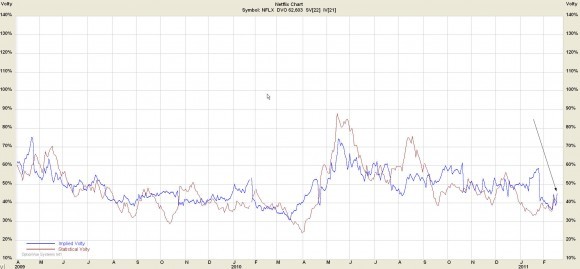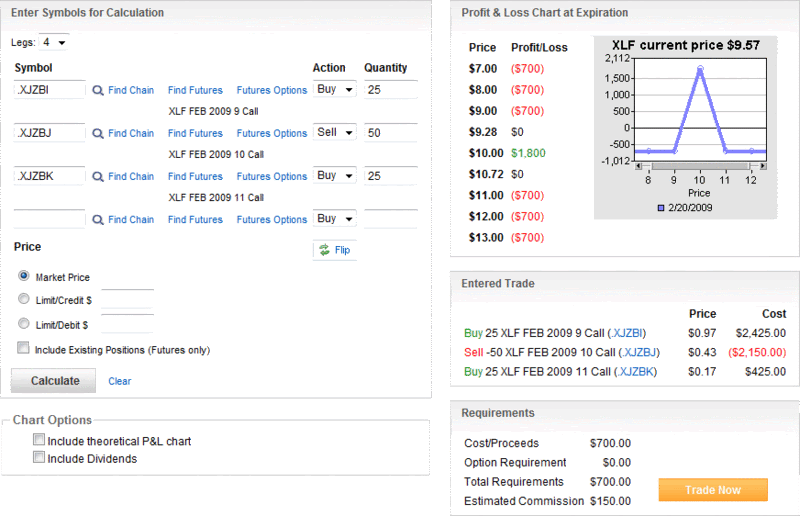How to Trade Directional View via Butterfly Spread
Post on: 13 Апрель, 2015 No Comment

by OptionPundit on July 16, 2013
Options is a versatile asset class and offers a lot of opportunities. Though most people think options are risky, if understood and done properly options can offer a wide variety of choices for retail traders including consistent monthly income. This post exhibits a powerful strategy for being long using Butterfly spread that limits the risk dramatically while increasing yield significantly.
Take directional trading for example.
Traditionally, a retail trader had only two choices for a directional view i.e. a) to either buy shares (if you are bullish) or b) short shares (if you are bearish). I am leaving out other methods that were not readily available for retail trades. The capital requirements were huge for such trades especially for high price stocks. For instance- If you were to go long Apple Inc. (AAPL ), you will have to buy 100 shares for $42,700 (@427/share LMP). Similarly if you are bearish, shorting 100 shares of AAPL will require substantial capital too. Traders later started using Options to leverage.
Let me explain the two via an example-
Outlook Assumption. You might be of the view that AAPL will touch 500 by Jan 2014 expiration (vs. $427 closing price).
- Your gains will be ($500-$427=$73) a total of $7,300; a large sum but still a respectable +17% gains.
- If However, you would have traded it using Jan 14 475 call options, your cost will be $1,270 and assuming AAPL does closes at 500 by Jan expiration, your gains will be ($500-$475=$2,5) a total of $2,500 or +96% .
- If however, the price is below $475 by Jan-14 expiration, you would lose all, limiting to maximum loss $1,270 in case of call option and $42,700 in case of 100 shares, if AAPL were to drop to $0.
Is there a third alternative ?
This is where a Butterfly spread fits in. Let me show you how:-
The butterfly spread is a neutral strategy that is a combination of a bull spread and a bear spread. It is a limited profit, limited risk options strategy. There are 3 striking prices involved in a butterfly spread and it can be constructed using calls or puts or both.
So for our case, here is the butterfly spread, using all CALLs:

- Buy to Open 1 AAPL Jan-14 475 Call
- Sell to Open 2 AAPL Jan-14 500 Call
- Buy to Open 1 AAPL Jan-14 525 Call
- Total cost: $180 only
Here is how the risk reward of this trade looks like.
A Long Call Butterfly Example on Apple (AAPL)
How to read this chart:
- This trade will make maximum profit of US$2,320 (that’s +1188% !) assuming AAPL is at exact $500 on Jan-14 option expiration.
- This trade will still be nicely profitable if AAPL is in between $476.8 and $523.2. That’s almost $50 range.
- The trade can’t lose more than $180 even if AAPL goes to zero.
It sounds too good to be true, so what’s the catch :
- Those profit figures will result in these gains, if and only if AAPL is between those strikes in Jan. If AAPL is within that range before Jan expiration, the gains will be smaller.
- Complete loss will occur only if AAPL is outside the range on Jan-14 expiration.
- Similar to buying share or a call option, this trade will result in loss if AAPL drops. The gains be smaller vs. if you had purchased call.
Bottom-line. So why should I think of trading butterfly spread?
When you have a directional view but you want to limit your exposure.
If it is timed properly, Butterfly can result in very high gains in a very short period of time for a limited risk.
Please dont start investing right away using Butterfly Spread. Though this is a beautiful and very powerful strategy but still there are many things to consider while structuring a butterfly spread. Paper trade it, evaluate it to see how it fits your trading style.
Should you have any questions, you may also ask me your questions at this e-mail address-> a. @OptionPundit.com. I will be glad to answer your questions.














